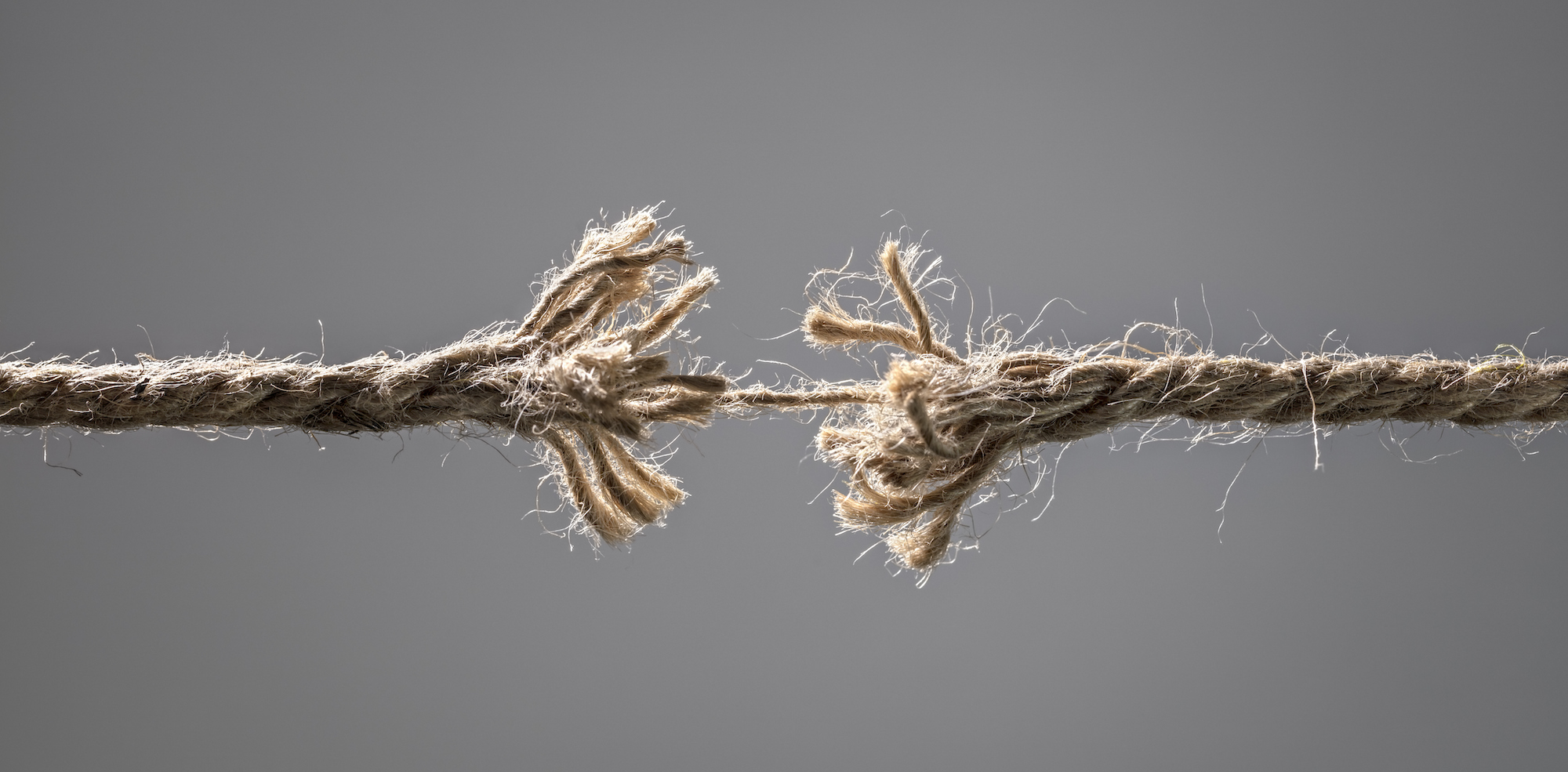After The Collapse, What Does Traditional Broadcast and Cable TV Look Like? (Bloom)
When the ‘thread’ they’re hanging from finally gives way, and the Traddies fall off the ‘precipice,’ where and how do they go splat?

It’s been bumpy few weeks of bad press for the traditional broadcast, cable and satellite TV business that’s made Hollywood rich over the past quarter century or so.
Ex-The Walt Disney Co. honcho Bob Iger told a conference last month that “linear and satellite TV is marching toward a great precipice, and it will be pushed off. … I can’t tell you when, but it goes away.”
Analyst Michael Nathanson laid into the equine corpse even more, issuing an apocalyptic update that said traditional broadcast and cable are “hanging by a thread,” even if the Traddies still generate four times the revenue of the suddenly blah streaming sector ($86.3 billion versus $22.6 billion).
Even the champions of the form are forced to damn with faint celebrations. NBC crowed about its ratings victory during “premiere week.” Only problem: NBC won that first week of fall with — and this is not a typo — a 1.1 rating in the demo that advertisers actually want to reach.
As LightShed Partners put it while talking about TikTok’s depredations on time spent with other entertainment options, “When we saw the list of top 20 premiere-week broadcast TV series, we were not sure whether to laugh or cry at how small the overall viewership was with 18-49 ratings getting closer and closer to zero.”
In the Before Times, when Traddies’ decline was more looming threat than lumbering reality, we called cable networks that got less than 1 rating point “zombies,” dead businesses that didn’t yet know it, shambling on thanks to channel bundles forced on hapless cable providers to harvest ever-rising carriage fees.
So what do we call NBC and the other broadcast networks now that a network-wide average of just over 1 rating point is considered “good?” Gumbies?
The smarter way to stay on top of the streaming and OTT industry. Sign up below.
More importantly, perhaps, what do the Traddies look like five or 10 years from now? Once they fall off that Iger-ian precipice, where do they go splat?
First, some rebalancing of hyperbole. Moffett suggests that post-apocalypse, Traddies will be left with “news, some sports, reality shows and ‘scripted leftovers.’ ” That’s a seriously not-awesome future. And it’s probably not wildly wrong.
After all, the broadcast institutions are already leaking off broadcast to streaming, like Dancing with the Stars and Days of our Lives.
In that $100 billion NFL deal the networks signed last year, the league remains on broadcast for the rest of the decade. That’s unless viewership gets really crummy. Then, media companies can shift it all to streaming, where Amazon and probably Apple already will have games. Already, these network NFL deals have more wiggle room than Lamar Jackson on a scramble.
And there’ll be far less of that expensive scripted stuff. NBC is reportedly considering — once again — dumping its 10 p.m. weeknight window. Dick Wolf must have been too exhausted from endlessly self-iterating his zillion shows to figure out who to cast for a new FBI Chicago Law & Order International Special Victims Unit Also With Doctors And Firefighters series.
More importantly than Wolf’s developmental shortcomings, the fact the NBC already is considering such a drastic move suggests someone at 30 Rock is thinking way beyond what’s happening right now.
And it’s not just primetime losing the hits these days. Trevor Noah’s announcement this week that he’s departing Comedy Central’s The Daily Show — on the heels of previous late-night exits by Conan O’Brien, Desus & Mero, Samantha Bee and (next year) James Corden — suggests that formerly lucrative segment is facing its own Darwinian cull.
For fans of the form, the departure of Noah — a young, biracial comic who appeals strongly to the young, diverse audiences abandoning traditional TV in droves — is a particularly notable loss. If Noah won’t stick around, who’s going to be left when the Jimmys and Steven head to retirement and their own Netflix interview shows?
That doesn’t mean Future Traddies won’t include late-night entertainment. But what exists then almost certainly won’t feature big-name hosts with big-money contracts. Maybe it’ll be more like The Daily Show before Jon Stewart turned it into a zeitgeist-shaper. Remember, however dimly, Craig Kilborn?
But broadcast doesn’t magically go away, either. Hundreds of stations in 300 markets don’t just evaporate like some Marvel plot line, and neither does their political influence. I know people who still get DVDs from Netflix (I’m visiting one as I write), or have an AOL email address, or listen to terrestrial radio. Hugely popular mass media platforms may fade, but they never seem to quite go away.
My colleague Alan Wolk pointed out that carriage and retrans fees, long the golden goose for broadcast and basic cable networks, are dropping alongside the viewership. That’s a big problem, especially for smaller cable networks, which must decide whether to shift fully to streaming. Advertising is unlikely to fill the hole in their budgets left by those lower carriage fees, however.
What to do then? Close? Or just be more like Canada or Europe, where legislators never mandated those fees/subsidies in the first place, so smaller networks had to figure out other ways to make a living.
I think we’ll see significant adaptation by the Traddies in coming years, as many figure out how to survive with smaller footprints.
Big sports rights deals, if nothing else, mean there’ll be at least some continued tune-in for what games remain there, though that’s only good until those deals expire.
ATSC 3.0 is one area of hope, though arriving far later than would have been ideal. The new digital broadcasting standard brings interactivity, multicasting on a single chunk of bandwidth, potential new data services like sports betting and targeted advertising, among other benefits.
I also like the possibilities contained in Evoca’s hybrid over-the-air and internet-connected approach. It gives local broadcasters and regional sports networks a real path to all the audiences in their home markets, better-quality audio and sound than streaming consistently delivers and more data and targeted advertising opportunities. Something like it could help many Traddies in the post-apocalyptic world beyond cable distribution.
Tie that in with the OpenAP format, which enables programmatic advertising that combines audiences on traditional and connected TV, and you start to see an opportunity to build a new broadcast business model.
That does nothing to fix the loss of Must Watch TV.
One possibility for new sources of broadcast programming? All the older but often great shows commissioned by Netflix and the other streaming companies that are now moldering in the back corners of the algorithm. Where better than broadcasters’ hours of available linear streaming windows to build new syndication and monetization opportunities?
Maybe those older shows come from big streaming services trying to monetize long-buried library content. Or maybe, they’re shows that have reverted back to creators, much as will happen with that new funding structure Netflix is using with some of its standup comedy specials, licensing the project for two years at about one-fifth the cost. That may become a template for far more than just standup comedy specials as streaming services cut upfront production expenses.
Combine the new funding sources, more capable delivery mechanisms, and a new source of (old) programming, and broadcast starts to look a little like Tubi and Pluto TV with an over-the-air delivery and some local originals. Maybe station groups commission a few scripted originals for their outlets. Throw in the continued political oomph that broadcasters will have, and it’s not hard to see them finding a way forward for an extended period to come.
For cable MVPDs though, it’s more complicated.
The big providers such as Comcast and Charter have long made far more money, with far fewer headaches, by selling broadband instead of TV bundles.
Sooner or later, the long-time cable operators may ditch the MVPD business entirely, leaving programming headaches and tight margins to virtualized competitors such as YouTube TV and Hulu Plus Live TV. Why bother with MVPD headaches if viewership keeps plummeting at 10% a year? Just give everyone’s app room on your delivery pipe, integrate with customers’ smart home devices and virtual assistants, and call it a day.
For everyone else in cable, though, Nathanson and Iger are right. You’re pretty much screwed. ▪️
David Bloom of Words & Deeds Media is a Santa Monica, Calif.-based writer, podcaster, and consultant focused on the transformative collision of technology, media and entertainment. Bloom is a senior contributor to numerous publications, and producer/host of the Bloom in Tech podcast. He has taught digital media at USC School of Cinematic Arts, and guest lectures regularly at numerous other universities. Bloom formerly worked for Variety, Deadline, Red Herring, and the Los Angeles Daily News, among other publications; was VP of corporate communications at MGM; and was associate dean and chief communications officer at the USC Marshall School of Business. Bloom graduated with honors from the University of Missouri School of Journalism.


